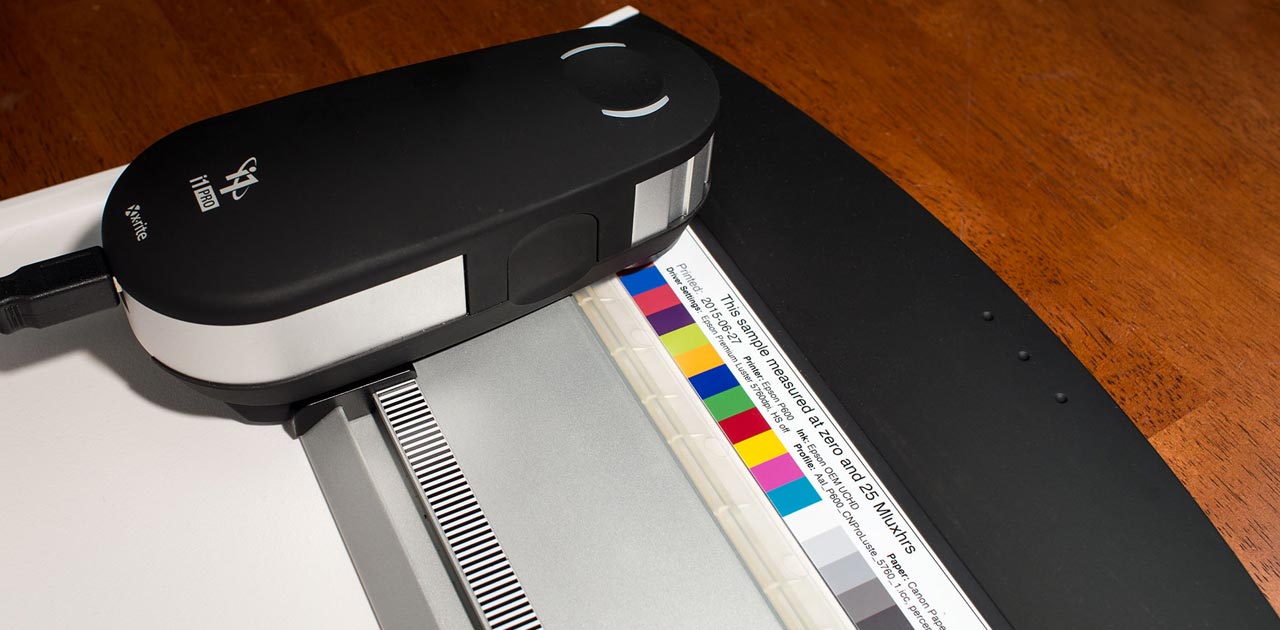
Our venerable Gretag Macbeth Spectrolino spectrophotometers have served us well and are continuing to do so in measuring the majority of the ongoing light fade tests here at Aardenburg Imaging & Archives. Nevertheless, Aardenburg Imaging has recently begun to phase in the much newer Xrite i1Pro2 instrumentation to perform most testing work going forward. Our first i1Pro2 unit was purchased last year from member donations to the Ardenburg general fund. Thanks to all who have donated.
The i1Pro2 conforms to the recently published ISO document 13665-2009: Spectral Measurement and Colorimetric Computation for Graphic Arts Images. This standard defines the spectral properties of the illumination source built into the spectrophotometer such that the instrument meets one or more of the specified M0, M1, and M2 measurement conditions. M0 defines the legacy illumination source of older spectrophotometers like the Spectrolino. M2 is a UV-cut illuminant condition where the UV component of the instrument’s light source is blocked, thus eliminating the fluorescence of any optical brighteners (OBAs) in the media. The new M1 specification adds additional UV radiation to the instrument’s light source such that OBA excitation and the measurement of the resulting media fluorescence is now effectively standardized between spectrophotometers which meet the M1 specification.
The i1Pro2 is also a scanning spectrophotometer that can measure and save the data for the M0, M1, and M2 conditions simultaneously. Most importantly for us, it takes the readings much more rapidly compared to our older instrumentation while maintaining the overall spectral and colorimetric accuracy critical to our research. The speed boost will in turn allow us to begin collecting even more measurements for all the printer/ink/media combinations we test, especially the long term dark storage properties of retired test samples and also a dark storage control sample that is not subject to any time on our accelerated light fade testing units. Again, it’s a big deal for labor efficiency. It would be impossible to keep up with our new data collection goals using our older hand-held Spectrolinos.
Speed with accuracy was the primary reason for beginning to phase in the new I1Pro 2 instrumentation, and the ability to measure the new M1 condition is icing on the cake! However, the new instrumentation called for a redesign of our 30 patch color target geometry as well as modifications to our light fade test unit configurations and to our Excel spreadsheets that automate the preparation of our published test reports. This work has now been completed, and our first samples using the new i1Pro2 workflow are now in test.
For our lightfastness studies, the reporting of the M1 specified colorimetric properties of the media will result in a subtle but systematic increase in the reported cool-white color appearance of OBA containing media, and in turn, the use of the M1 condition will further emphasize the magnitude of any loss of fluorescence in the media due to fading of the OBAs. Yes, just when you thought OBA fading an issue in fine art media, it’s about to get more significant. Expect to see “new and improved” test reports with M0, and M1, and M2 measurement data where applicable and also new graphs that introduce long term dark storage tracking of the test samples. The new reports should begin to appear in the Aardenburg Database during calendar year 2017.
Mark H. McCormick-Goodhart
Director, Aardenburg Imaging & Archives


